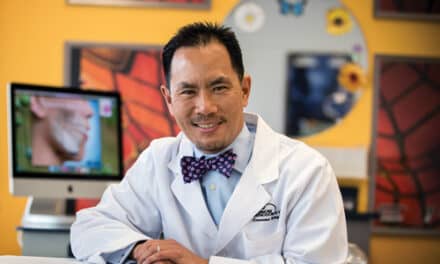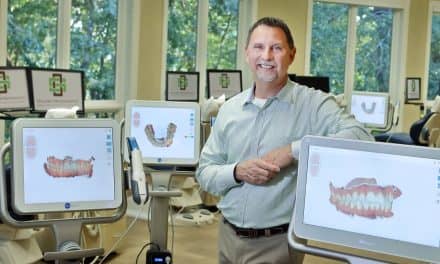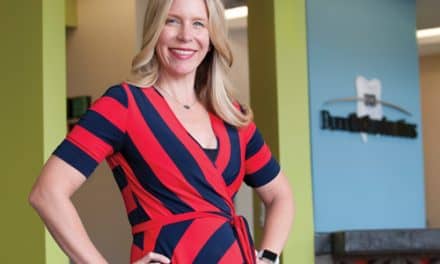by Sarah Schmelling
Douglas Bennion, DDS, built a practice—and a building—with his brother the oral surgeon
What comes to mind when you think of family businesses? Furniture stores, car repair shops, home-style restaurants … dental practices? Douglas Bennion, DDS, an orthodontist, and John Bennion, DDS, MD, an oral surgeon—two brothers who recently built a shared practice space from the ground up—know this kind of partnership doesn’t happen every day. They’re also very aware of the many pitfalls of going into business with a family member. But these unique business partners wouldn’t have it any other way.
“I think the two of us together are better than either one of us would be separately,” Doug says, and he’s learned this from experience. The two worked close to each other for years, but they only opened a new office building specifically designed for them just over 1 year ago. And in that time Doug has seen his business grow by 40%: an increase due in part to the new, high-tech office, but also due to a strong family partnership in a community that values long-term roots.
Two for the Road
The Bennion’s working brotherhood now seems ideal, but it was a long time in coming. Doug explains that both brothers, having grown up in a small town in rural Wyoming, wanted to live in the closest metropolitan area: Billings, Mont. But it took a little while to get there.
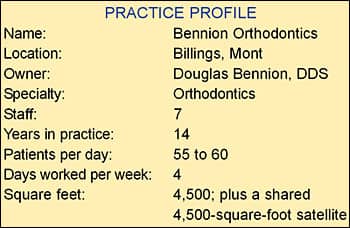
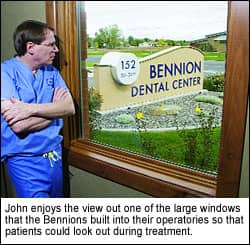
For several years, the two—now an oral surgeon and an orthodontist—worked in the same office building, across the hall from each other, “and we enjoyed working in close proximity to each other,” John says. “And when I left that group to go to another building, we found that we missed having our offices close together—the ability to walk across the hall and look at a case or give each other ideas on an x-ray or something like that, even if it was something we weren’t both working on. We just valued each other’s ideas and enjoyed working closely, and we missed that when I moved.”
When John left that building, the brothers both started considering having a new office built, one in which they could both practice independently but still have space for collaboration.
“In 2002, we started exploring the possibility of building a building,” Doug says, “and that’s when I started going around. … I went to [places like] San Francisco and Salt Lake City and looked at different office designs. I spent some time talking to dentists about what they liked and didn’t like about their offices. I even went to some seminars to learn as much as possible about effective design and traffic flow.”
From the Ground Up
To design their ideal building, the Bennions began working with a national architectural firm, but then they switched to a local company for help in determining the size of the office and how exactly it would work. Each brother had specific design elements he wanted incorporated into the new building. Both wanted to make sure the space was inviting, that “people weren’t afraid to come into it, and when they walked in it was a very comfortable,” Doug says. “We wanted it to be large enough that people didn’t feel cramped.”
They wanted high ceilings and a lot of indirect lighting to put patients at ease, so “there are hardly any lights in our whole office that are direct. Most are bounced off a ceiling or a wall,” Doug explains. “We wanted the patient flow to be comfortable for the patient and also for the staff. We wanted enough room for the staff to have their own private areas—staff lounge, changing room, their own private restroom—so that they feel like they have some areas they can go on break.”
He says they wanted a high-tech office that didn’t necessarily look ultra-techy. “I don’t like messy things like wires showing, so we hid most of the CPUs in cabinets,” Doug says. “The only things showing are monitors; even the keyboards aren’t showing; they’re in drawers to keep everything nice and clean-looking.”
Within his office, Doug wanted an area “where the kids wanted to come,” so they created a colorful game room with systems like Nintendo® and PlayStation® “where the kids can hang out,” he says.
Doug wanted his operatories to have “big windows to have patients be able to look out, but I didn’t want to deal with the sun,” so they designed the building so his operatories would all face north.
John says he wanted an office “that was spacious enough to feel that our patients and staff could move around the office comfortably and not feel crowded. I wanted to have an office that was open to a certain extent with high ceilings and wide hallways and bigger rooms.”
He says he knows oral surgery patients are naturally apprehensive, and “confined, close spaces tend to make them more anxious, so a big part of the design of the office was to make an environment that would relax people and that would be soothing and comfortable, and it’s worked out that way.”
Patients often comment on the relaxed atmosphere in his office, he says. “There’s still the natural apprehension about oral surgery, obviously, but the openness and design of the office has really added to patient comfort, and staff comfort as well.”
The brothers specifically designed the building to share a common entryway, and for it to appear as if the offices are separate. But both practices are actually joined in the back, where they share pieces of equipment, including a high-end CT scan machine, and where they can confer on x-rays and lab work.
Putting all of these different requirements into the design plans proved a bit challenging.
“There were a lot of obstacles we had to jump through when we did the floor plans,” Doug says, adding that he believes they went through at least 10 to 15 drafts of the plans. “We just kept working on it until we found the [right] traffic flow and everything that would work,” he says. “And we designed the floor plan first—we designed the size of the building—and after we had the floor plan and the traffic flow the way we wanted it, then we designed the structure to fit over the top of it.”
A Plan in Motion
The new, 10,000-square-foot office opened in July 2005, and the brothers say it has received a very positive reception from patients, parents, and staff.
Doug says the new building’s success is partly due to the brothers coming together, working under the “Bennion Dental Center” umbrella, which “gets our name out there.” But he also says they both have “exceptional staffs” that deserve a lot of the credit.
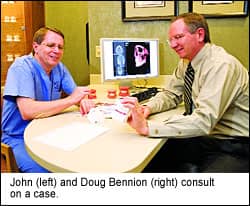
He says that through the combination of the two brothers having a long-standing reputation in the community and their reputation for good service, the practices are thriving. “[The building] is visible, we’ve been around a long time, we try to treat people great. … I think it’s the combination of those things.”
John says that even if they weren’t brothers, having an orthodontist and an oral surgeon working together would be beneficial to their practices. He explains that his brother teaches him about orthodontics, which benefits his work, and he can help his brother learn about aspects of oral surgery. On top of this, “I suppose it just makes good economic sense to share a building with someone. To build a building of this size is more economical than to build two smaller buildings, so when we decided to build it, it was a natural decision,” he says. “I don’t think the thought of doing it any other way ever crossed either of our minds.”
The Technological Edge
In addition to the shared CT scanners, the new building’s technology includes digital x-rays and photography, computers to do all tracings, and offices that are virtually paperless, with all new chart information entered on computers. In fact, Doug says in his office alone there are 20 computers.
Both brothers admit to just loving new technology. “It has always interested me, and I like to be on the cutting edge of new equipment and new things that come out,” Doug says. “What keeps me interested in orthodontics and practicing and working is just trying to change things and better things, and when new things come out I like to take what they have to offer and use them as much as possible.”
“We look at some of the high-tech advances as making our patient care better,” John agrees. “For example, the CT machine that we have, a year ago when we got it, I thought it was a luxury, and now I would hate to practice without it. It allows me to do a better quality of patient care. Some of the things we look at on the orthodontic side do the same thing—they reduce the patient’s time in the office, they reduce our time working on them, they speed up the treatment time, and improve the overall quality of the result. … It improves quality of patient care, and that’s what our major goal is.”
All of this technology, along with the building’s design philosophy, will transfer to a new satellite office that the brothers will work out of starting this fall. Significantly smaller than the primary office at 4,500 square feet, the office is designed so only one Bennion can be there at a time. The brothers used the same architectural firm, and strove to create within it a similar sense of openness and space. “We wanted to make it have a lot of the same feeling,” Doug says, “so we used the same brick, we used the same shingles, we have an archway that looks similar to our building. … We wanted it to have its own identity, but still be tied very strongly back to this office.”
The satellite office, situated about 15 miles from the larger building, will also be wirelessly connected to the central server. And in the long term, Doug says that he could see them sharing that space when they want to “slow down” and work just a few days per week.
Sibling Synergy
Call it a quirk of an age difference, but the Bennion brothers see no problems in working together. At 5 years older, John says that growing up, he didn’t have as strong a relationship with Doug as he does now. “I graduated from high school when he was in junior high,” he says. But, after they grew up, went to college, went into similar fields, and ended up in the same city, it turns out “it was almost scary how much alike we were,” John says. “We had been apart most of our lives, but we found we liked the same things—our wardrobes were scary they were so close—and it was just astounding to us. Sometimes we just laugh at the things we both do, even though we spent all those years apart.”
Doug agrees that they have a good working relationship that has been very successful. “We have a lot of give and take,” he says. “If he can’t do something, he just tells me what he can’t do. We don’t have to worry about stepping on anybody’s toes. It’s just an easy, good relationship that we have.”
John says that of course people should be cautious about going into business with family, but they haven’t had any problems, and adds, “The upside for us is that we push each other a little bit as far as quality and excellence of patient care.
“I see the standard he sets in orthodontics, and it pushes me to look for that same level in oral surgery,” he says. “And it’s been a very positive experience, challenging each other.”
Sarah Schmelling is a contributing writer for Orthodontic Products.


